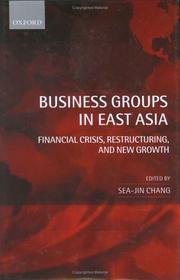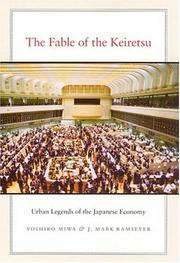| Listing 1 - 2 of 2 |
Sort by
|

ISBN: 0191536954 1423757335 1281154512 9786611154516 9780191536953 9780199287345 0199287341 Year: 2006 Publisher: Oxford OUP Oxford
Abstract | Keywords | Export | Availability | Bookmark
 Loading...
Loading...Choose an application
- Reference Manager
- EndNote
- RefWorks (Direct export to RefWorks)
The 1997 Asian Crisis principally affected Thailand, Indonesia, Malaysia, and Korea, as well as other East Asian countries heavily dependent on intra-regional trade. Banks and other financial institutions quickly become insolvent, and heavily indebted industrial firms went bankrupt. Many of these firms were affiliated with the business groups of this region, yet most groups did not immediately collapse, indeed they proved remarkably robust, some surviving and even prospering.This book examines these East Asian business groups and their subsequent restructuring following the Asian Crisis. East
Conglomerate corporations --- Financial crises --- East Asia --- Economic conditions --- Chaebols --- Conglomerate mergers --- Conglomerates (Corporations) --- Corporations, Conglomerate --- Keiretsu --- Mergers, Conglomerate --- Asia, East --- Asia, Eastern --- East (Far East) --- Eastern Asia --- Far East --- Consolidation and merger of corporations --- Corporations --- Industrial concentration --- Competition --- Orient

ISBN: 0226532704 9786612537417 0226532720 1282537415 9780226532721 9780226532707 9781282537415 6612537418 Year: 2006 Publisher: Chicago, Ill. University of Chicago Press
Abstract | Keywords | Export | Availability | Bookmark
 Loading...
Loading...Choose an application
- Reference Manager
- EndNote
- RefWorks (Direct export to RefWorks)
For Western economists and journalists, the most distinctive facet of the post-war Japanese business world has been the keiretsu, or the insular business alliances among powerful corporations. Within keiretsu groups, argue these observers, firms preferentially trade, lend money, take and receive technical and financial assistance, and cement their ties through cross-shareholding agreements. In The Fable of the Keiretsu, Yoshiro Miwa and J. Mark Ramseyer demonstrate that all this talk is really just urban legend. In their insightful analysis, the authors show that the very idea of the keiretsu was created and propagated by Marxist scholars in post-war Japan. Western scholars merely repatriated the legend to show the culturally contingent nature of modern economic analysis. Laying waste to the notion of keiretsu, the authors debunk several related "facts" as well: that Japanese firms maintain special arrangements with a "main bank," that firms are systematically poorly managed, and that the Japanese government guided post-war growth. In demolishing these long-held assumptions, they offer one of the few reliable chronicles of the realities of Japanese business.
Economic order --- Japan --- J4411 --- Japan: Economy and industry -- industrial organization and relations -- conglomerates, zaibatsu, keiretsu --- Conglomerate corporations - Japan. --- Conglomerate corporations -- Japan. --- Corporations - Finance. --- Corporations -- Finance. --- Japan -- Economic conditions -- 1989-. --- Japan - Economic conditions - 1989-. --- Japan -- Economic policy -- 1989-. --- Japan - Economic policy - 1989-. --- Industrial Management --- Management --- Business & Economics --- Economic policy --- Economic conditions --- Conglomerate corporations --- Corporations --- Finance. --- Business finance --- Capitalization (Finance) --- Corporate finance --- Corporate financial management --- Corporation finance --- Financial analysis of corporations --- Financial management, Corporate --- Financial management of corporations --- Financial planning of corporations --- Managerial finance --- Going public (Securities) --- Finance --- E-books --- keiretsu, business, japan, economy, alliance, corporation, preference, trading, shareholding, lending, marxism, conglomerate, main bank, management, growth, economics, zaibatsu, outside directors, government, regulation, assistance, loyalty, honor, market, central planning, myth, urban legend, profit, industrial policy, networks.
| Listing 1 - 2 of 2 |
Sort by
|

 Search
Search Feedback
Feedback About UniCat
About UniCat  Help
Help News
News